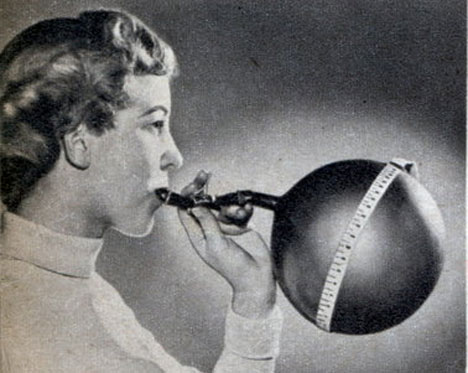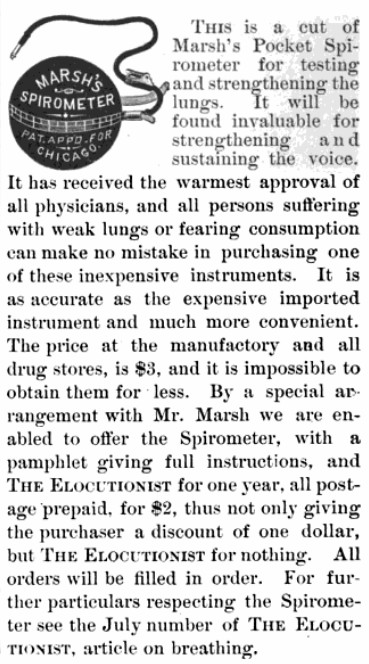
Found on Gajitz.com. Looks like Marsh’s spirometer but sold as a “bust enhancer”. Photo was undated but looks like it came from the 1950’s.

Found on Gajitz.com. Looks like Marsh’s spirometer but sold as a “bust enhancer”. Photo was undated but looks like it came from the 1950’s.

From The Elocutionist: : Devoted to the Science and Art of Elocution, and Choice Selections for Reading, Recitation and Declamation, H.M. Dickson editor, 1882, page 188.
From patent number 225, 710 by J.P. Marsh, Mar 23, 1880.
“A is a flexible bag or receiver, made of india-rubber, by preference, and expansible to such a degree as to be capable of being distended with facility by air expelled from the human lungs into the receiver.
“B is a flexible tube coupled to the part A. The tube B should be provided with a mouth-piece at its free end, as indicated at a.
“C is a gage or measuring-tape, connected at one end to the part A, preferable at the place where the tube B is coupled thereto.
“In using this device as a spirometer, the piece a is inserted into the mouth of the user, and the remaining part held in any convenient way which will not interfere with the inflation of part A. The part A may then be inflated by being blown into, and as soon as the capacity of the lungs is thus sufficiently tested the tube B should be pinched together to prevent the air from escaping from the receiver. The gage C should then passed around the inflated receiver, as indicated in Fig. 1, and where the fixed end of the gage meets the encircling part thereof will be found figures indicating the amount in cubic inches of air in the receiver, whether there be more or less therein, being understood that part C is graduated for that purpose, and that it will be taken up more o less by encircling the receiver, according to the amount of air forced therein from the lungs of the user. In this way the user may test the capacity and strength of his lungs, and note their condition in these respects, and a proper use of the device will, it is believed, be found to be a healthful exercise for the lungs.”
From: Catalogue of Sharp & Smith, Importers, Manufacturers, Wholesale and Retail Dealers in Surgical Instruments, Printed by Blakely Printing Company, 1889, Page 529.
Advertisement from: The Homoeopathic Guide, Published by Munson & Co., 1881. Fronticepiece.
To use Marsh’s spirometer the subject exhaled into the balloon. A measuring tape attached to the balloon measured the circumferance and therefore the volume exhaled. A criticism from elsewhere was that the balloons broke frequently and that it required 20 mm Hg of pressure “before any test of the expired breath can be recorded”.